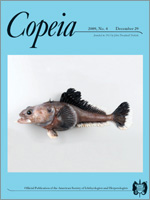Interspecific competition for resources is predicted to be high in dense populations of closely related species and should lead either to species partitioning resources along one or more niche axes, or exclusion of the competitively inferior species. Between 19 June and 19 July 2003, we collected 71 recently metamorphosed Rana areolata (Crawfish Frogs) and 69 recently metamorphosed R. sphenocephala (Southern Leopard Frogs) from a single pond in northeastern Oklahoma and compared their morphology and diet. We found that recently metamorphosed R. areolata and R. sphenocephala are morphologically similar. Further, diets of both species were similar: hemipterans predominated, prey items were similarly sized, and dietary niche breadths overlapped, but R. areolata had significantly lower volumes of prey in their stomachs. Because of the high risk of desiccation, especially in Great Plains populations, newly metamorphosed Rana are not expected to disperse far from their natal ponds. During this first season, Rana also experience rapid growth. Dietary restrictions directly influence growth rate, which in turn are known to have major consequences during later life stages, ultimately affecting fitness. Rana areolata is a species of conservation concern across its range. Competitive interactions with other species of Rana have been proposed to be contributing to declines in R. areolata. Our results indicate that competitive interactions with R. sphenocephala have the potential to negatively affect prey consumption, and ultimately fitness, in R. areolata.
How to translate text using browser tools
29 December 2009
Diet Composition and Overlap between Recently Metamorphosed Rana areolata and Rana sphenocephala: Implications for a Frog of Conservation Concern
John A. Crawford,
Donald B. Shepard,
Christopher A. Conner
ACCESS THE FULL ARTICLE





